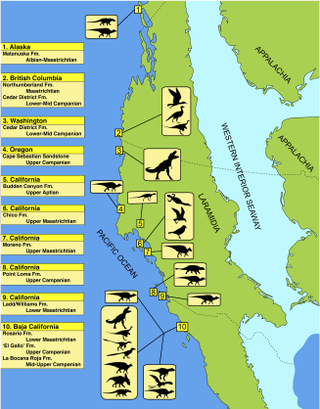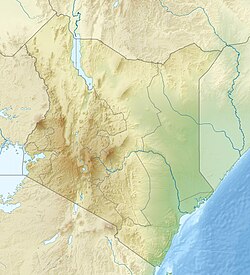The El Castellar Formation is a geological formation in La Rioja and Teruel, Spain whose strata date back to the possibly the Valanginian to the Barremian stages of the Early Cretaceous. Dinosaur remains are among the fossils that have been recovered from the formation.
The El Picacho Formation is a geological formation in Texas, United States, whose strata date back to the Late Cretaceous. Dinosaur remains are among the fossils that have been recovered from the formation. The paleosols found here are rich in clay, calcite, and rhizoliths which show that during the Cretaceous period, this fossil formation, just like the neighboring Javelina Formation and Aguja Formation, was a fluvial flood plain.
The Ankarafantsika Formation is a Late Cretaceous (Cenomanian) geologic formation of the Mahajanga Basin in the Boeny region of Madagascar, Africa. The fine-grained sandstones of the formation were deposited in a fluvial to lacustrine environment.
The Bahia Group, also known as Bahia Series, is an Aptian geologic group of the Recôncavo Basin in Bahia, Brazil. Dinosaur remains are among the fossils that have been recovered from the formation, although none have yet been referred to a specific genus. The conglomerates were deposited in an estuarine environment.

The Cape Sebastian Sandstone is a Mesozoic geologic formation in the state of Oregon in the United States. Hadrosaurid dinosaur remains, such as the sacrum of the Cape Sebastian ornithopod, are among the fossils that have been recovered from the formation, although none have yet been referred to a specific genus. The formation dates to the Campanian stage of the Late Cretaceous epoch.
The Chilgog Formation, also known as the Chilgok Formation, is an Early Cretaceous geologic formation in South Korea. Formerly dated to the Berriasian to Hauterivian, later dating has established an Albian age. Dinosaur remains, possibly of sauropods, are among the fossils that have been recovered from the formation, although none have yet been referred to a specific genus.
The Kootenai Formation is a Lower Cretaceous geologic formation. The Kootenai was deposited in a foreland basin east of the Sevier thrust belt in western Montana. The lithology consists of a basal conglomerate with overlying non-marine sandstones, shales and lacustrine limestones.
The Mabdi Formation is a Late Jurassic geologic formation in western Yemen. It is considered Kimmeridgian in age based on invertebrates. It is laterally equivalent to the Sabatain Formation. It consists of limestone, sandstone and shale deposited in a nearshore shallow marine setting during widespread marine transgression on the Arabian Shelf. Remains of vertebrates, including Dinosaurs have been recovered from the formation. These include the remains of an indeterminate sauropod as well as those of hybodont sharks, pycnodont fish, turtles, and crocodilians. The sauropod was found in hard calcite cemented sandstone, not all of the bones of the individual were collected, with many remaining at the locality pending further excavation
The Molecap Greensand is a Late Cretaceous geologic formation, located in the state of Western Australia in Australia.
The Quantou Formation is a Cretaceous Period geologic formation in China. It is primarily Albian in age. It has been explored for its potential as a tight oil reservoir.
The Shendi Formation is a Late Cretaceous geologic formation of the Atbara-Shendi Basin in northern Sudan. Indeterminate theropod remains have been recovered from it. As well as those of the dyrosaurid Hyposaurus. It consists of a lower unit of fine grained meandering channel sediments, separated by an erosive contact with overlying meandering to braided river channel sandstones.
The Sierra Perenchiza Formation is a late Campanian to late Maastrichtian geologic formation in Spain. Dinosaur, pterosaur, turtle, lissamphibian, frog and albanerpetontid remains are among the fossils that have been recovered from the formation, although none have yet been referred to a specific genus and the crocodylomorphs Acynodon, Doratodon ibericus and Musturzabalsuchus are also known from this formation.
The Ankazomihaboka Formation is a Coniacian geologic formation in the Mahajanga Basin of northwestern Madagascar. The formation comprises claystones and sandstones deposited in a fluvial to lacustrine environment. The formation is overlain by the Marovoay Beds and overlies basalt.
The Broome Sandstone, formerly known as the Broome Beds, is an Early Cretaceous geologic formation found in Western Australia, and formerly considered part of Dampier Group. Fossil sauropod tracks, belonging to an unknown ichnotaxon, and stegosaur tracks belonging to the ichnogenus and species Garbina roeorum have been reported from the formation.
The Sagog Formation, also known as the Sagok Formation, is an Albian geologic formation in South Korea.
The Precipice Sandstone is a Hettangian geologic formation found in the Surat Basin of Queensland and New South Wales in Australia. Fossil ornithopod and theropod tracks have been reported from the formation.
The Thomas Fork Formation is an Early Cretaceous (Albian) geologic formation in Wyoming. Fossil dinosaur eggs have been reported from the formation.
The Marnes Rouges Inférieures Formation is a Late Cretaceous geologic formation found in the French Pyrenees. It predominantly consists of red mustone, with minor brown mudstone and sandstone. Dinosaurs, dinosaur eggs and avialian stem-birds have been reported from the formation.
The Lossiemouth Sandstone is a Middle to Late Triassic age geological formation. It is exposed on the south side of the Moray Firth near Lossiemouth and near Golspie in Sutherland. Dinosaur remains are among the fossils that have been recovered from the formation.
The Jeomgog Formation is an Early Cretaceous (Albian) geologic formation of the Hayang Group in the Gyeongsang Basin of South Korea.

